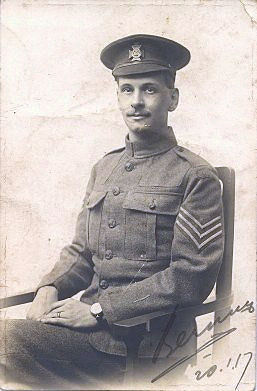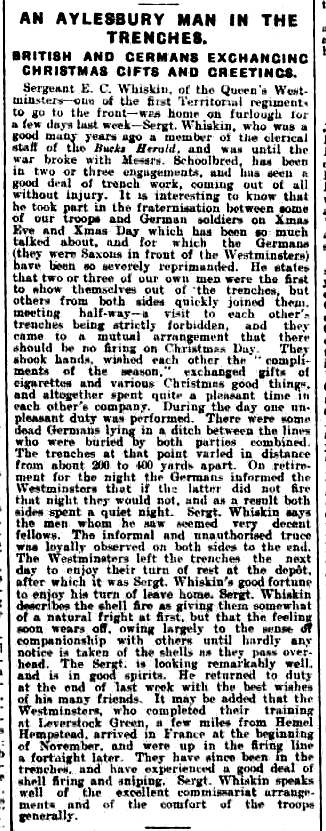|
The Queen's Westminster Rifles (16th London Battalion) at Leverstock Green, 1914 |
|
The War Journal of Bernard Joseph Brookes
Notes made when I was drafting "The London Gunners Come to Town"
Page Refs in London Gunners: 134, 141-143, 147, 149, 162
The War History of the 1st Battalion Queen's Westminster Rifles, 1914-1918 by Major J Q Henriques, includes a chapter (14 pages) on Mobilization and Training, about half of which deals with the period they spent at Leverstock Green. Bernard Brookes' Journal, a microfilm version of which is held in the Department of Documents, Imperial War Museum, contains rather more personal details.
Brookes, B J PP/MCR/283
Ts journal (106pp) with additional related letters, postcards and other material, covering his enlistment and training in London and Hertfordshire in the Queen's Westminster Rifles (1/16th Battalion, London Regiment) from August-October 1914 ...
Bernard Joseph Brookes enlisted 7th August, 1914, and volunteered to go overseas on the 11th. On the 28th they took the tube to Euston Station, and then a train to Boxmoor. From there they marched to Leverstock Green where "E Company" were given quarters at Well Farm2. He was later made a signaller. The following text consists of short extracts from his journal.
30th August, 1914: The next day being a Sunday, the Catholics paraded in undress uniform and marched to Church at Boxmoor3, and as it was a quiet day and we had no equipment, we quite enjoyed the journey. At the Church Sergeant-Major W J Price (who had lately been awarded the D.C.M.) came up with his men (R.F.A.) and I had a chat with him again feeling proud (I soon lost my pride however) - a Rifleman on familiar terms with a Sergeant-Major. During the afternoon I called on Frank Carroll in the Civil Service Rifles at Bedmond (which by the way was out of bounds) and we had tea in a cottage.
We had a Field day on the 7th September and the next day the Brigade (13th County of London, The Kensingtons; 14th London Scottish; 15th Civil Service Rifles; 16th ourselves) turned out for a Route March, and the Queens Westminster led the Brigade.
About this time the village Post Office4 found that they could not cope with the extra work which the influx of troops had occasioned, and it fell to the lot of the signallers to take over the work connected with telegrams, and tender messages to sweethearts and wives had to be left at the mercy of the Signal Service Section.
The 2nd London Division went for a Route March on Monday the 21st September, and the Artillery was also in attendance, but there was very little pleasure in a Route March of this description. It is so slow, and the length of the troops in fours being so great, the unfortunate battalions at the rear get a great deal of dust.
Our Great day was on Monday 29th September when the Division was inspected by Lord Kitchener. ... Instructions were received during the night and we had an early breakfast, parading on the Green at 7.0am. We marched, accompanied by the Band, to a Park near St Albans, the name of which I cannot bring to mind5. We were by no means the first battalion on the scene, and it was a blazing hot day. The Division was drawn up the slope of a hill, and as we marched to our position we could see a dense mass of men with bayonets brightly shining and rifle barrels reflecting the rays of the sun. We took up our position, and at the appointed time Lord Kitchener put in his appearance. After inspecting the Infantry, the Artillery "marched past" and one wondered how the Germs could possibly think that they could win the War when there were so many men and guns. It took a long time for the guns to pass and we were at "Attention" all the time. No wonder such thoughts were in my mind.6
The next item of interest was the three days firing at Hemel Hempstead7, commencing on Thursday the 1st October. After I had fired my first shot I thought the world had come to an end. The "kick" of the rifle gave me an awful hit on the jaw and also bruised my shoulder badly. Of course the moral is to hold one's rifle tightly ...
On Saturday the 10th October the signallers were moved into a Farm by themselves ... It was very comfortable, and the quarters were better that those in which we had been.
The country around was very pretty, and we had many day's outings (pardon Battalion and Brigade Field days) when we had to cook our own dinner. On the whole we enjoyed them immensely, especially the signallers with their bicycles who somehow or other often managed to get lost, but they could usually be found in the local "pub".
We were all up early on Sunday the 1st November for we had plenty to do. Of course the village turned out to wish us "Good-bye". The Battalion went in two parts, the right half under the Colonel, and the left half under Major J W Cohen at 10.30am. The Band struck up "Auld Lang Syne" as the left hand battalion moved off. Only the signallers were left, and we dismissed for a short time and entered the "Tuck Shop", and at 11.0am left Leverstock Green on our bicycles for Watford, arriving there about 11.30am. The Battalion had a good reception when marching through the town.8
************************************



